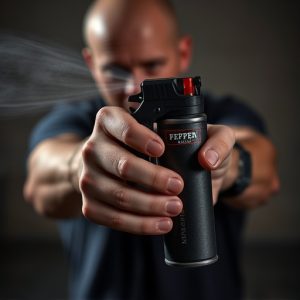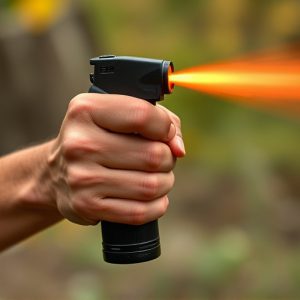Mastering Non-Lethal Inflammatory Self-Defense with Pepper Spray
Non-lethal inflammatory self-defense tools like pepper spray offer a safe and powerful option for pe…….
Non-lethal inflammatory self-defense tools like pepper spray offer a safe and powerful option for personal protection in close quarters, temporarily disorienting assailants. Legal usage requires understanding regional laws, aiming at specific body areas, training, practice, and keeping the tool accessible. Choosing the right type of pepper spray based on potential threats and concentration levels is essential. Proper handling involves using it as a last resort, understanding local regulations, mastering aiming techniques, and practicing de-escalation methods to enhance safety without endangering bystanders.
In today’s diverse and often unpredictable world, understanding non-lethal inflammatory self-defense tools is paramount. Among these, pepper spray stands out as a popular option for personal safety. This comprehensive guide delves into the intricacies of using pepper spray safely and legally. We explore when it’s appropriate to deploy this powerful tool, how to choose the right type for your needs, and essential safety precautions to ensure its effectiveness. By understanding when to use pepper spray safely, you empower yourself with a crucial self-defense mechanism.
- Understanding Non-Lethal Inflammatory Self-Defense Tools
- When is Pepper Spray Legal and Safe to Use?
- Choosing the Right Pepper Spray for Your Needs
- Safety Precautions and Training for Effective Defense
Understanding Non-Lethal Inflammatory Self-Defense Tools
Non-lethal inflammatory self-defense tools, such as pepper spray, offer a powerful yet safe option for personal protection. These tools create a temporary but intense irritation, disorienting and disabling potential assailants long enough to enable escape or assistance arrival. Pepper spray is particularly effective in close-quarters confrontations, providing users with a crucial advantage in situations where lethal force may not be justified or desirable.
When used safely and responsibly, pepper spray can significantly enhance an individual’s ability to defend themselves. It’s important to understand the appropriate times to deploy such tools—for instance, when facing physical threats, during attempts at robbery, or in scenarios involving animal attacks. Proper training on usage, including awareness of wind direction and safe handling, is essential to ensure effectiveness while mitigating risks.
When is Pepper Spray Legal and Safe to Use?
Pepper spray, a non-lethal inflammatory self-defense tool, is only legal and safe to use in specific circumstances. Its application is governed by local laws and regulations, which vary significantly across regions. Generally, pepper spray is permitted for personal protection when an individual faces an imminent threat or danger from an attacker. This includes situations like being followed, approached, or physically assaulted, providing the user has a reasonable belief of harm.
To use pepper spray safely, it’s crucial to understand and follow guidelines from manufacturers and local authorities. Users should aim for the eyes, nose, and mouth of the assailant, as these areas are highly sensitive to capsaicin, the active ingredient in pepper spray. Training and practice are essential to ensure accurate deployment without endangering bystanders or oneself. Additionally, keeping pepper spray readily accessible and familiarizing oneself with its use can significantly enhance personal safety in potentially dangerous situations.
Choosing the Right Pepper Spray for Your Needs
When considering a non-lethal inflammatory self-defense tool like pepper spray, understanding your specific needs and intended usage scenarios is crucial. Different types of pepper sprays cater to various situations, from personal safety at home or while traveling, to outdoor activities such as hiking or running. Knowing when to use pepper spray safely involves assessing the potential threats you may encounter and choosing a product that aligns with those requirements.
For instance, if you’re primarily concerned with personal protection in close quarters, like indoors or in confined spaces, a higher concentration of capsaicin (the active ingredient in pepper spray) is beneficial. Conversely, for outdoor use where distance plays a factor, consider lighter strengths suitable for spreading over larger areas. Additionally, features like weather-resistant cans and various application methods (e.g., aerosol, foam) can enhance usability in different environments.
Safety Precautions and Training for Effective Defense
When it comes to non-lethal self-defense tools like pepper spray, safety precautions and proper training are paramount. It’s crucial to understand when and how to deploy such devices effectively while minimizing risks. Pepper spray, for instance, should only be used as a last resort when facing an imminent threat of physical harm. Users must be aware of local laws and regulations governing its possession and use, ensuring they have the legal right to carry and employ it.
Training is essential to guarantee safe and responsible usage. Learning proper technique includes aiming, distance, and understanding the spray’s range and duration. Practice sessions can help individuals become familiar with the spray’s effects, allowing them to respond calmly under pressure. Additionally, training should cover de-escalation techniques, promoting peaceful resolution whenever possible.
In understanding non-lethal inflammatory self-defense tools, particularly pepper spray, it’s clear that knowing when and how to use it safely is paramount. By adhering to legal guidelines and implementing proper safety precautions, individuals can effectively protect themselves while minimizing risk. Choosing the right pepper spray tailored to personal needs, along with thorough training, ensures its safe deployment in dire situations. Remember, responsible use of non-lethal self-defense mechanisms plays a crucial role in maintaining personal security without causing harm.


